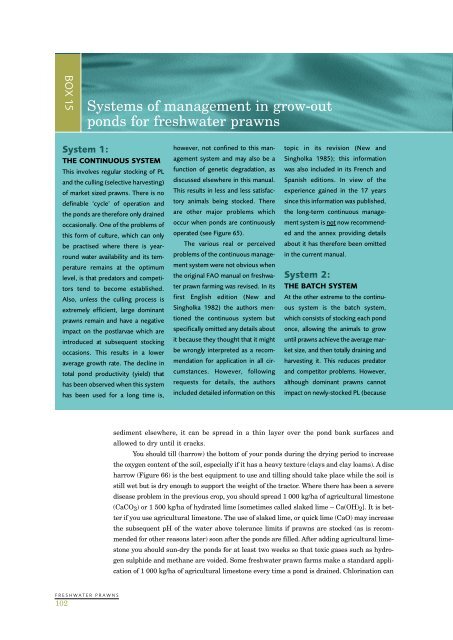Create successful ePaper yourself
Turn your PDF publications into a flip-book with our unique Google optimized e-Paper software.
BOX 15Systems of management in grow-outponds for <strong>freshwater</strong> <strong>prawns</strong>System 1:THE CONTINUOUS SYSTEMThis involves regular stocking of PLand the culling (selective harvesting)of market sized <strong>prawns</strong>. There is nodefinable ‘cycle’ of operation andthe ponds are therefore only drainedoccasionally. One of the problems ofthis form of culture, which can onlybe practised where there is yearroundwater availability and its temperatureremains at the optimumlevel, is that predators and competitorstend to become established.Also, unless the culling process isextremely efficient, large dominant<strong>prawns</strong> remain and have a negativeimpact on the postlarvae which areintroduced at subsequent stockingoccasions. This results in a loweraverage growth rate. The decline intotal pond productivity (yield) thathas been observed when this systemhas been used for a long time is,however, not confined to this managementsystem and may also be afunction of genetic degradation, asdiscussed elsewhere in this manual.This results in less and less satisfactoryanimals being stocked. Thereare other major problems whichoccur when ponds are continuouslyoperated (see Figure 65).The various real or perceivedproblems of the continuous managementsystem were not obvious whenthe original FAO manual on <strong>freshwater</strong>prawn farming was revised. In itsfirst English edition (New andSingholka 1982) the authors mentionedthe continuous system butspecifically omitted any details aboutit because they thought that it mightbe wrongly interpreted as a recommendationfor application in all circumstances.However, followingrequests for details, the authorsincluded detailed information on thistopic in its revision (New andSingholka 1985); this informationwas also included in its French andSpanish editions. In view of theexperience gained in the 17 yearssince this information was published,the long-term continuous managementsystem is not now recommendedand the annex providing detailsabout it has therefore been omittedin the current manual.System 2:THE BATCH SYSTEMAt the other extreme to the continuoussystem is the batch system,which consists of stocking each pondonce, allowing the animals to growuntil <strong>prawns</strong> achieve the average marketsize, and then totally draining andharvesting it. This reduces predatorand competitor problems. However,although dominant <strong>prawns</strong> cannotimpact on newly-stocked PL (becausesediment elsewhere, it can be spread in a thin layer over the pond bank surfaces andallowed to dry until it cracks.You should till (harrow) the bottom of your ponds during the drying period to increasethe oxygen content of the soil, especially if it has a heavy texture (clays and clay loams). A discharrow (Figure 66) is the best equipment to use and tilling should take place while the soil isstill wet but is dry enough to support the weight of the tractor. Where there has been a severedisease problem in the previous crop, you should spread 1 000 kg/ha of agricultural limestone(CaCO 3 ) or 1 500 kg/ha of hydrated lime [sometimes called slaked lime – Ca(OH) 2 ]. It is betterif you use agricultural limestone. The use of slaked lime, or quick lime (CaO) may increasethe subsequent pH of the water above tolerance limits if <strong>prawns</strong> are stocked (as is recommendedfor other reasons later) soon after the ponds are filled. After adding agricultural limestoneyou should sun-dry the ponds for at least two weeks so that toxic gases such as hydrogensulphide and methane are voided. Some <strong>freshwater</strong> prawn farms make a standard applicationof 1 000 kg/ha of agricultural limestone every time a pond is drained. Chlorination canFRESHWATER PRAWNS102
















